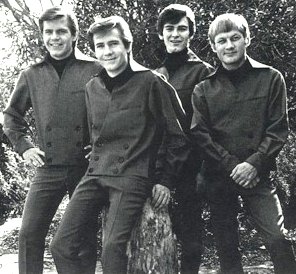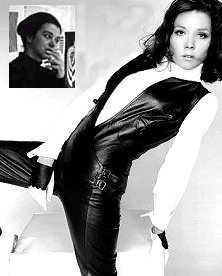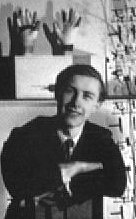|
|

|
and
influencers of Sixties fashion
|
Geoffrey Beene - Born Samuel Albert Bozeman Jr, he his first design job was at Teal Traina, where he stayed until 1963, leaving to launch his own label. Beene's 'signature' designs included elaborate seams, architectural construction, graphic black and white motifs and clinging silhouettes cut on the bias and were an immediate success. US Vogue featured Jean Shrimpton wearing a dress from his first collection and within four years he had an annual turnover of $4 million.
"What I'm trying to do are clothes that look effortless without any degree of calculation on the part of the wearer, but plenty of calculation on my part,"
Defying fashion conventions, he shocked the fashion world in 1966 with his use of grey flannel and wool jersey in evening wear. The following year he designed the wedding dress of Lynda Bird Johnson, eldest daughter of President Lyndon B. Johnson. Also that year, Beene became the first American designer to show in Milan and the first to open a manufacturing outlet in Europe, selling couture clothes and sportswear both there and in the Far East. Noted for men's and women's wear in soft, easy care fabrics, sequinned fabrics, chiffon and taffeta. One of the first designers to mix patterns and textures. Generally preferred dark and neutral colours
Bonnie Cashin - U.S. designer specialising in Chinese styles, Leather, canvas and suede with ethnic influences, best known for popularising the 'poncho'.
Gabrielle 'Coco' Chanel - Classic Paris high fashion and the tailored 'Chanel suit'. Also a range of sports style fashions and the famous 'Chanel No5' perfume.
| Ossie Clark - Youth fashions influenced by op-art. Hot pants, Maxi Coats, Gypsy dresses, motorcycle jackets, metallic leather and snakeskin. Later in the decade, flowing romantic evening wear and Latin-inspired fashions. Clark had designed for the Woodlands 21 boutique, having his fashions featured in Vogue. He started his own company, Quorum, in 1965 with partner Alice Pollock which was to become one of Chelsea's most successful boutiques. Quorum was bought by Radley in 1968 but Clark continued to design for the new company, later specialising in crepe, satin, jersey and chiffon. |
 |
Andre Courreges - Miniskirts, pantsuits and see-through space-age designs. He opened his own fashion house in 1961 after 12 years designing for Balenciaga. Like Mary Quant, he has some claim to having pioneered the introduction of the mini skirt in 1962. His most famous designs were the 'Space-Age' collection of Spring 1964 which strongly featured silver and white PVCs with bonded seams. The collection included silver PVC 'moongirl' pants, white catsuits and monochrome striped mini skirts and dresses. He is also famous for his use of the mid-calf length, flat-heeled 'Courreges' boot - an iconographic symbol of Sixties fashion. A more reasonably priced ready-to-wear collection was produced in 1965.
Marc Bohan ( Design director - Christian Dior ) - Paris high fashion elegance. Marc took over the reigns at Dior in 1960 after the departure of Yves Saint Laurent.
Elio Fiorucci - Miniskirts and general youth fashion. Italian shoe designer who exported many Sixties London fashions to Italy, opening a store in Milan, 1967, specially for London products.
Anne Fogarty - One of the first U.S. designers to produce bikinis and launcher of the 'Paper Doll' dress, with high waist, low neck, short-sleeved bodice and full skirt.
Rudi Gernreich - Sports and swimwear, revealing designs. Rudi designed ready-to-wear clothes for Los Angeles boutique JAX until 1964 when he started his own company, striving to provide a range of clothes which allowed complete freedom of movement. He is credited with introducing the topless swimsuit in 1964, which consisted of a high waist held up by thin straps which passed between the bare breasts. He gave up the company in about 1967 to concentrate on freelance designing and to devote more time to his passion - dance clothes.
Hubert de Givenchy -
Cocktail and evening dresses. Most famous for the clothes he designed
for Audrey Hepburn, particularly her wardrobe in the 1961 film 'Breakfast
At Tiffanys'. He is generally known for sack dresses, low-cut cocktail
dresses with matching boleros, duster coats and coloured gloves.
Janet Reger
- London born designer who worked in Zurich until
the late Sixties when she returned to London and marketed her products
through Fenwick stores.
Betsey Johnson
- Pantsuits, miniskirts and t-shirt dresses
Jacques Heim
- One of the designers credited with the introduction of the bikini. Owned
a chain of boutiques selling sportswear between 1946 and 1966.
Emanuelle Khanh - lacy, frilled dresses and blouses, long collared jackets
Emilio Pucci - Sportswear and psychedelic skirts, dresses and pantsuit
| Mary Quant - Miniskirts, tights, skinny-rib sweaters and wet-look PVC. She produced designs for Butterick Patterns ( paper patterns ) in 1964 to enable her styles to reach a larger market amongst the less well-off. Mary is largely responsible for establishing London as the Sixties centre of fashion, particularly the King's Road area of Chelsea. |
 |
Paco Rabanne - Plastic and metal discs, day-glo space-age designs. Between 1964 and 1966 Paco designed fashion accessories on a freelance basis for Balenciaga, Givenchy and Dior. He launched his body jewellery in the Spring of 1966 on forming his own company. Generally known for clothing in chain-mail style, made from plastic and metal tiles or discs, held together with wire. By 1968/9 his designs included ostrich feather dresses with aluminium bodices and others made in paper and silver leather.
| Zandra Rhodes - Fantasy evening fashions in vivid colours and bizarre patterns. Printed and painted silk and chiffon garments with art-deco motifs, zig-zags etc. Prior to forming her own fashion house in 1968, she had already designed a paper wedding dress which sold for less than two shillings ( ten pence ) during the brief period of popularity enjoyed by disposable clothing. |  |
Michelle Rosier
- Space-age and wet look designs
Vivienne Westwood -
Opened a shop in the Kings Road in the late 60s with Malcolm McLaren (
of Sex Pistols fame ). Better known for 70s 'Punk' and 80s 'New Romantic'
fashions.
Oscar de la Reuta - Designer for
major fashion houses, working for Balenciaga, Lanvin-Castillo, Elizabeth
Arden and Jane Derby. Started his own business in 1965 specialising in
extravagant, opulent designs. Mainly elaborately-trimmed evening wear,
particularly gypsy-style designs.
|
Alberto Fabiani - Married rival designer Simonetta in 1953 and opened a Paris house together in the 60s. Couturiers and accessory designers, tailored suits and evening dresses, evening culottes. John Stephen - Suede waistcoats, kaftan jackets, velvet flares, 'groovy' wigs Terence Conran - ( right ) The major force in raising design awareness during the Sixties. He opened his first 'Habitat' store at 77 Fulham Road in May 1964, concentrating on modern furniture and accessories. Douglas Millings - Beatles' suits and men's fashion. Giorgio Armani - Worked as a designer with Nino Cerruti from 1961 to 1974 |
|
Barbara Hulanicki - Started her business by mail-order in 1963 with her husband, Stephen Fitz-Simon. Due to a phenomenal response to their newspaper advertising, they opened their first 'Biba' boutique in 1964, selling mini smock-dresses, mix'n'match fashions, rubberised raincoats, floppy hats and lengthened and dyed rugby shirts which were worn as mini-dresses, many of which were decorated with op-art designs. Their favoured colours were muted purples, dull reds, sepias, blues, greys and pinks. They moved to larger premises in 1965 and again in 1969 when they opened a department store in Kensington High Street, selling men's, women's and children's wear ( even purple nappies! ). They also sold a variety of foods and household goods but the expansion of the range seemed to be the start of Biba's fall from youth popularity, eventually closing down in 1975.
Roberto Capucci - Flamboyant use of Mediterranean colours and sculptural forms. He famously produced garments made of sealed plastic filled with coloured water.
Cristobal Balenciaga - Highly fashionable in the fifties, the house of Balenciaga carried on through the Sixties with famous name designers producing loosely tailored suits and sculptural evening wear. Balenciaga retired in 1968.
Laura Ashley - Country style clothing and furnishing fabrics. Laura started with a cotton drill apron in 1961 - almost an anti-fashion house featuring inexpensive tucked and frilled dresses in coarse cotton and lacy shirts with leg o'mutton sleeves. She opened her first shop in Kensington in 1968.
Anthony Price - Glamorous evening wear and the designer of the clothes for The Rolling Stones' 'Gimme Shelter' tour of 1967, while working as a designer for Stirling Cooper producing fashions for Miss Selfridge. He also later designed for Bryan Ferry and Roxy Music.
Valentino Garavani - Decorative evening wear and tailored day wear. While still a student, he won a prestigious prize for fashion design by the International Wool Secretariat (an award also won later by both Yves Saint Laurent and Karl Lagerfeld). This led to his being employed by Jean Desses in 1950. Valentino assisted Desses for five years before moving to work for Guy Laroche, a former chief illustrator at Desses. He launched his first salon on the Via Condotti in Rome in 1960. When he showed his first collection that year, he gained huge recognition for his sophisticated, Hollywood-style evening wear. He also drew regard for his full-length skirts ( despite the popularity of mini skirts) his penchant for simple contrasts of black and white and his signature 'Valentino red'. His success resulted in a Paris boutique and the launch of the famous 'V' label. In 1967, he won the coveted Neiman Marcus Prize and presented a 'No Colour' collection produced entirely in creams, buffs and whites, in contrast to the highly fashionable psychedelic colouring of the period. By 1969 he was producing designs heavily influenced by op-art and, in 1970, launched his first ready-to-wear line, with more boutiques following in Rome and New York. For over 40 years, known simply as 'Valentino', he has been one of fashion's most prominent names, designing some of the world's most elegant evening wear and classic creations.
|
Charles Jourdan - Brightly-coloured suede and leather shoes. He also designed for leading fashion houses including Dior and Cardin. Calvin Klein - Klein taught himself how to sew and sketch as a boy, earning a place at New York's High School of Art and Design and the Fashion Institute of Technology. He finally launched his own label in 1968, in partnership with childhood friend Barry Schwartz. Noted for peajackets, turtleneck sweaters and long-line slacks. Karl Lagerfeld - Flamboyant evening wear and furs. He worked for Patou until 1964, later designing on a freelance basis for Chloe and Krizia. He also designed shoes for Charles Jourdan and furs for Fendi from 1967. Jean Muir
- Tailored
and fluid matte jersey womenswear. Regarded by many as 'The Greatest
British Fashion Designer', Jean started at Jaeger from 1956 to 1961
when she left to produce her own range of fashions under the 'Jane
and Jane' label. This became part of the Susan Small organisation,
later to be owned by Courtaulds. She opened her own company in 1966
producing comfortable and elegant women's wear including smocks,
peasant dresses, shawls, draw-string waist dresses and two-piece
suits. |
 The Bobby Fuller Four in mod 'sharkskin' |
Roger Vivier
- Evening and
haute couture shoes, also freelance footwear design for fashion houses.
Bill Blass
- American sportswear and traditional designs with
softened lines. Use of ruffles in 60s designs
Donald
Brooks
- Luxurious evening pants and voluminous pyjamas,
chemises, unadorned dresses, trimmed coats and stoles.
Stephen Burrows
- Leather fashion specialist
Caroline Charles
- Worked with Mary Quant in the early days and started
up her own business in 1963. Mini skirts in cotton and flannel, tunics,
pants and, later, long flowing fashions.
Clive ( Clive Evans )
- Opened his own boutique in 1961, specialising
in haute couture and ready-to-wear daywear.
Sybil Connolly -
Hand woven woollens, tweeds and mohairs. Evening and daywear.
| Yves Saint Laurent - Safari and pea jackets, smocks, pantsuits, see-through designs. He opened his own fashion house with Pierre Bergé in 1962, having had to leave his previous position at Dior in 1960 to fight in the Algerian war. He launched the 'Mondrian' look in 1965 and a collection that was inspired by pop-art in 1966, establishing his chain of 'Rive Gauche' boutiques which provided new fashion ideals for the richer youth of the period. Also in 1966, he introduced 'le smoking', his legendary smoking suit, which prompted the consequent androgynous revolution. He is now credited with a range of other innovations including the reefer jacket (1962), the sheer blouse (1966), and the jumpsuit (1968), as well as ready-to-wear culture as a whole. |  |
Dorothee
Bis - Opened a boutique in 1962 with
Elie & Jacqueline Jacobson-designed 'adult' versions of young girls
clothes. Knee socks, peaked caps, cut-out dresses, trouser suits and crocheted
sweaters and dresses.
Luis Estevez
- U.S. West Coast designer specialising in glamorous
evening wear.
Marion Foale and Sally Tuffin
- Formed Tuffin & Foale in 1962, designing for
the young, ready-to-wear market which was bought extensively by London
store Woollands. Best known for lace dresses with cut-outs under the arms.
Frederick Fox
- Milliner who opened his own business in the mid-60s, designing hats
for Hardy Amies, John Bates and the royal family.
Andrew Grima
- Jewellery designer who opened a business in Jermyn
Street in 1966
Ralph Lauren
- Ralph Lauren's empire was founded in 1967, after
he opened his first ever tie shop, with no formal design training. Noted
for 'Ivy League' styles and expensive neckwear, including 'kipper' ties.
Simone Mirman
- Milliner who designed for Dior, Saint-Laurent
and Hartnell, including hats for the royals.
Rose Vernier
- Milliner who designed for Amies, Creed, Morton
and Mattli.
Tommy Hilfiger -
Made his first moves into the fashion industry in 1969, while still in
high school, with $150 and 20 pairs of bell-bottom jeans which he sold
out of his Volkswagen to New York campus kids.
|
|
UK
Web Hosting by
Velnet web
hosting UK | Search
Engine Optimisation & Submission by Submit
Express
Web Address Domain Names from Web Hosting Shop |
All
original material
|



